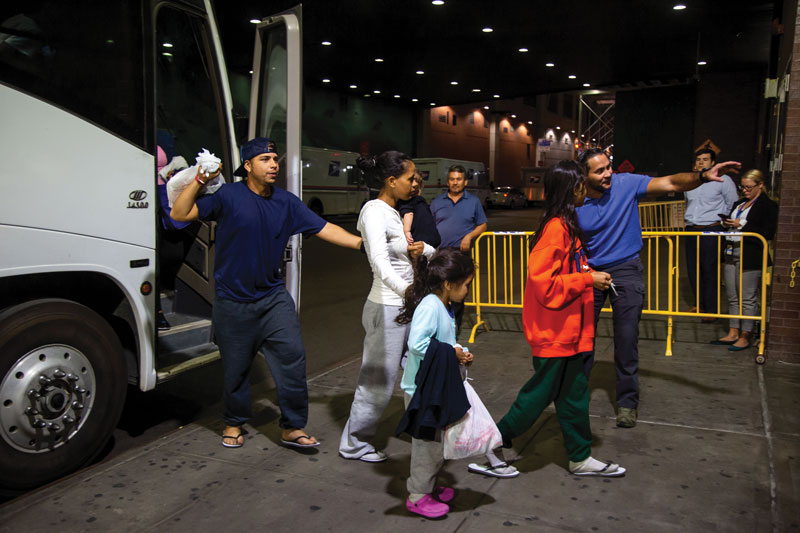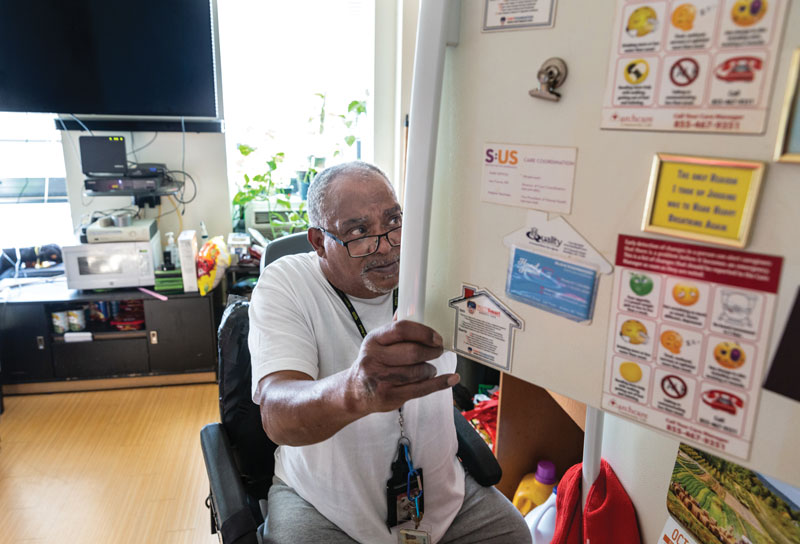“It takes a little while to transition,” said Daniel Broome, who lived on the street for five years before living in a Bronx building created by Breaking Ground. “When I started, this was like my crash pad. Then it became my apartment. Then it became my home.”
The Trust has a long history of addressing homelessness across the five boroughs, Long Island, and Westchester. The hard-won successes of its grantees are both notable and a reminder of the tough task of helping those still living on the streets, in subways, and in shelters.
The city’s unhoused population is the highest it’s been since the Great Depression. Causes include the decline in affordable housing, soaring rents, and individual crises such as job losses, domestic violence, and health issues. In addition, the health and economic consequences of the pandemic disproportionally hit communities of color, which were already struggling with housing insecurity.
According to the Coalition for the Homeless, there were more than 63,000 people, including 20,000 children, in city shelters every day this past October. Obscured by these statistics are the stories of the sons, daughters, friends, and family members who have become unhoused.
“We are people, not just a number,” said Felix, one of the Coalition’s constituents. “I am homeless, but not hopeless.”
A growing crisis
The arrival of more than 20,000 immigrants by bus from the nation’s southern border has renewed attention to the city’s homelessness crisis and overwhelmed a system already beyond capacity. While The Trust expedited a grant to Havens Relief Fund Society to meet the basic needs of these migrants, much more must be done.
The city’s homeless population is estimated at 80,000. The average stay in the shelter system is 483 days for single adults and 520 days for families with children. Unhoused people face grave dangers—last year 16 died from exposure—and lack basic essentials. The average age of death for people without housing is 51 years old. But the difficulties can extend far beyond the physical.
“Regrettably, I lost the respect and friendship of a lot of people,” Broome recalled about his days on the streets of Bedford-Stuyvesant, his home even if there was no roof over his head. “Because their patience was short, and I can’t blame them. I got all kinds of insults. I became numb to it.”
Decades of discrimination, particularly in housing, have led to the loss of generational wealth in communities of color, which are overly represented in the unhoused population. While Black New Yorkers make up 24 percent of the city’s population, 56 percent of the homeless population is Black. People with disabilities are also disproportionally affected: 68 percent of single adults in the system have a disability.

Our history of helping
In its earliest days, The Trust addressed poverty through grants for food, clothing, and shelter. The roots of what some call “modern homelessness” began in the 1970s with the decline in single-room occupancy units and the closing of in-patient psychiatric facilities, leading to more individuals without stable housing. Then, over the years, economic factors resulted in more families becoming homeless.
As a result of a 1979 lawsuit, New York City—unlike other large U.S. cities—was required to provide shelter to people without it.
The Rhodebeck Fund for the Homeless, established in 1989, allowed The Trust to address short- and long-term solutions. Richard Rhodebeck, a Brooklyn-born insurance executive, and his wife, Mildred, created the fund with $285,000. Because of prudent investments, it has made $660,000 in grants over the years to local nonprofits. Like the Rhodebecks, many other generous New Yorkers have established funds at The Trust to address homelessness, but more support is needed.
Providing stable housing
“Because the city is facing enormous needs and The Trust’s resources are limited, our focus is on the big picture,” said Shawn Morehead, vice president for grants. “When it comes to housing, that means expediting access to appropriate housing and improving services to stabilize families.”
As the city has grown, affordable housing development hasn’t kept pace. In one innovative approach, Breaking Ground partnered with for-profit developers to take advantage of city incentives to include 20 percent affordable housing in market-rate buildings. The partnerships led to 19 development projects.
There is also a dire need for supportive housing, which provides affordable, independent housing matched with comprehensive services for those facing mental illness, abuse, or addiction. Using several Trust grants, the Supportive Housing Network of New York led a campaign that resulted in city and state commitments to create 35,000 supportive apartments over 15 years.
“Supportive housing is now widely accepted as the most humane and effective approach to resolving a seemingly intractable social problem for people who have the greatest barriers to obtaining and maintaining housing,” said Network Executive Director Pascale Leone. “It allows people to rebuild their lives in the community. We feel it is the ultimate efficiency in helping get people off the streets and out of shelters.”
Recalling his days before supportive housing, Broome said, “I was asleep for like five years. I was doing drugs. I was an alcoholic. I lost focus on my perspective, my identity. I felt sort of robotic.”
One day, a Breaking Ground team member who had encouraged him to apply approached him on the street and said: “Daniel, are you ready to go home?”
When he arrived at his new home, he was asked what he’d do first. “Scuba diving” in his new bathtub, he joked. The next day the city was hit with a major snowstorm, and Broome looked out the window, convinced he would not have survived.
In the six years since, he has encouraged others to seek assistance. He said, “I’ve had people who told me: ‘I wouldn’t be in a program if it hadn’t been for you. I would have been in a lot of trouble.’ It’s an emotional reward to hear someone say they appreciate your help. I’m giving back something that was given to me.”
The New York Community Trust – Long Island also is creating supportive housing. Its grants to Wyandanch Homes and Property Development Corporation are helping people achieve economic stability with housing that offers career counseling and financial literacy programs.
In addition to making grants to spur affordable housing, The Trust teamed with SeaChange Capital Partners to make low- or no-interest loans available to nonprofits. With our investment in the New York Pooled PRI Fund, SeaChange made a pre-development loan to Children’s Village and Community League of the Heights to support the expansion of the Inwood Library that will include affordable housing, classrooms, and a community center.
Streamlining services
Trust grantmaking has made services more effective by cutting red tape. Coordinated Behavior Care will bring together service providers and government to streamline the system so people with mental-health and substance-use needs can get into empty supportive apartments. Similarly, The Public Policy Lab will help the city improve the Section 8 rent voucher system—where delays have led landlords to turn away Section 8 tenants.
While Westchester is considered a wealthy enclave, nearly 90 percent of its lower-income earners pay more than 30 percent of their income toward housing. To help them, The New York Community Trust – Westchester made grants to Community Voices Heard for its grassroots advocacy to improve affordable housing.
Helping high-risk groups
“A key investment,” said Morehead, “is working proactively with the groups who are more likely to become homeless.”
Two high-risk groups—young people and older adults—are separated by decades but both have limited incomes and employment opportunities. To help, Streetlives is creating a phone app for young people so they can read peer-written reviews about places offering shelter, food, or healthcare. And LiveOn NY is advocating for affordable housing for older adults, whose fixed incomes cannot always meet their basic needs—a pressing concern given that 4,000 are in shelters, and many wait up to 10 years for affordable housing.
Improving the odds
We believe that though these tens of thousands of people are unhoused, they do have a home: New York. As we have for nearly 100 years, The Trust will channel the compassion of generous New Yorkers to improve the quality of life for all our neighbors, particularly those who have the least.
“There were several times I almost lost my life out there,” said Broome, who is now affectionately called “The Mayor” of his building. “I’m looking at it like I’m living on my second chance and I’m not taking the chance of seeing if I got another. I’m forever grateful for the opportunity to get my life back together.”
